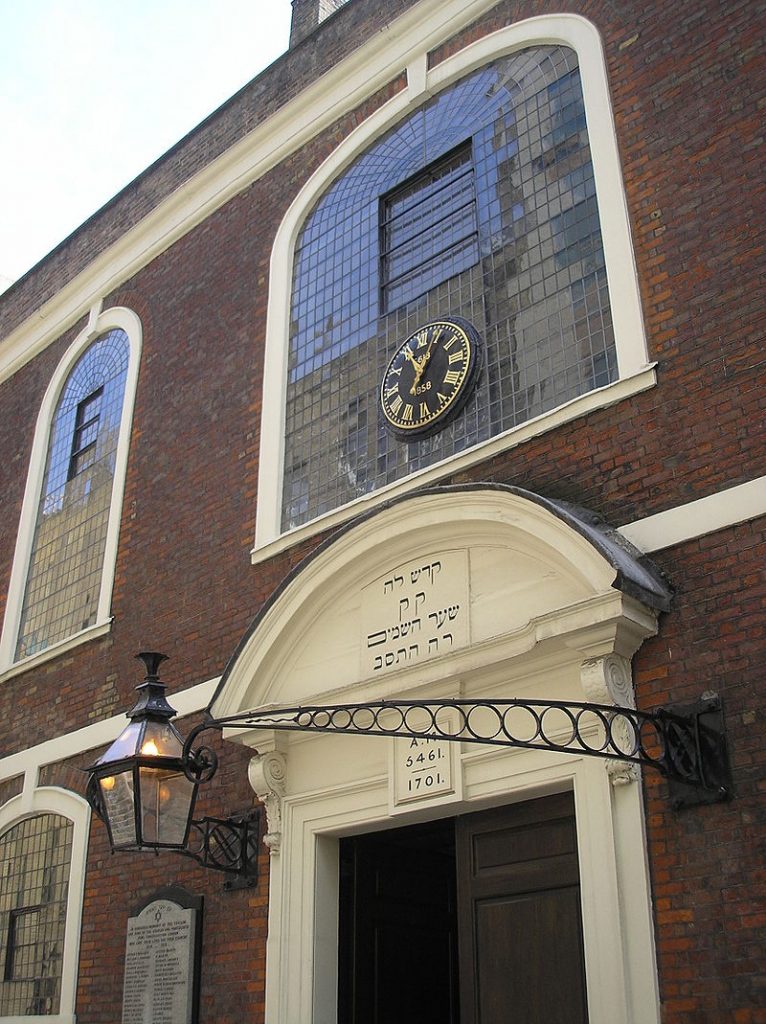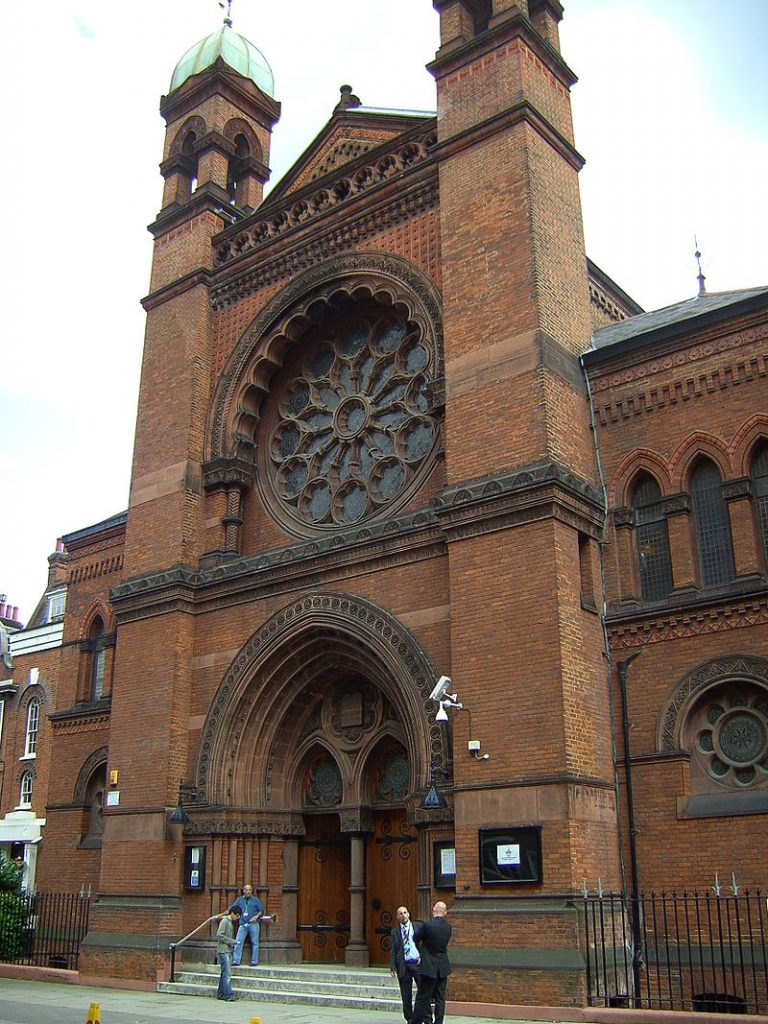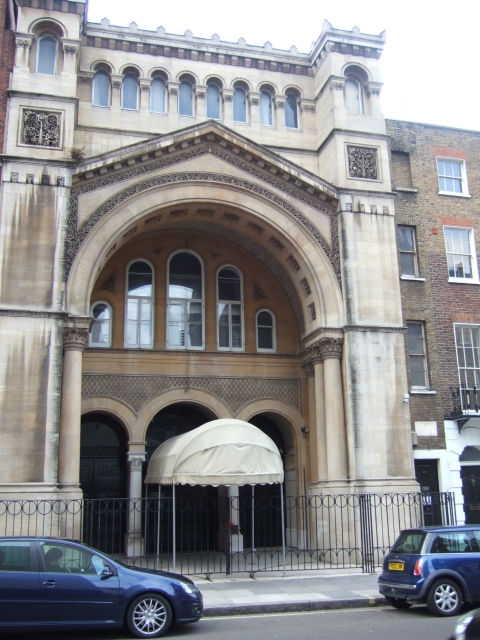Of the Jewish presence in the City during the Middle Ages, there remains little more than memories, but it is a pleasure to walk around here. The three streets around the Bank of England -Poultry, Cheapside, and Old Jewry- were home to a community before the expulsion of 1290.
Jewry street, near Aldgate Underground station, is where the Jews took refuge during the riots that broke out at the coronation of King Richard I in 1189. And in Creechurch Lane the Cunard building marks the spot where the first synagogue was built in London after Cromwell’s decision to allow Jews back onto English soil.
Bevis Marks frequented by Disraeli and Montefiore
Still close to Aldgate Underground station, up Duke’s Place, we come to Bevis Marks Synagogue , which was built in 1701 by the Portuguese and Spanish Jews after the return of the Jews from 1655 onward. The synagogue was located within the city walls, and its site was chosen so that it would not be visible from the street because the community wanted to remain discreet.

Extremely well preserved, it is one of the oldest and most handsome synagogues still in use in Great Britain today. It also has a rich history, having been frequented by Sir Moses Montefiore and Benjamin Disraeli and because of its links with the Rothschild family. In addition, it houses one of the finest sets of pews from the Cromwellian and Queen Ann periods. The interior was strongly influenced by the mother synagogue in Amsterdam, which indeed donated one of the candelabras.
Jewish life near the docks
The East End has a long tradition of immigration. Located close to London’s docklands, it welcomed Huguenots and Irish immigrants and, after them, Jews. Today, its population is mainly made up of immigrants from India, Pakistan, and Bangladesh. This evolution is amusingly embodied in the history of the gloomy building on the corner of Fournier Street and Brick Lane: originally a Huguenot church, it later became a synagogue and is now a mosque. Before World War II, some 100,000 Jews lived here. There are now only 6,000. To get an idea of the old days, read Israel Zangwill (1864-1926), called the “Jewish Dickens”. Zangwill paints a highly enjoyable and marvelously vivid picture of Jewish daily life here during the late nineteenth and early twentieth centuries.
The synagogue on Princelet Street is a real treasure. Built in 1870 on the foundation of an old Huguenot house dating from 1709. It was closed in 2020. In the area still, you’ll find the Dutch Synagogue on Sandy’s Row , installed in a Huguenot chapel of 1766.
Promenades in the West End’s quarters and gardens
The West End of London also has plenty to satisfy visitors’ curiosity. The history of British Zionism reminds us that Chaim Weitzman and other Zionists used to meet at 17 Piccadilly, which is also where Lord Rothschild received Lord Balfour’s famous letter on 2 November 1917. Hyde Park has a small garden laid out in 1983 in memory of the Shoah.

The New West End Synagogue is one of London’s finest. The first stone was laid on 7 June 1877 by Leopold de Rothschild, and the synagogue opened on 30 March 1879. It is similar in appearance to the Princes Road Synagogue in Liverpool. Both were built around the same time by the same architect, George Audsley. There are fine stained-glass windows, as well as twenty Sifrei torah, embroidery, and silverware from the early eighteenth century.
The synagogue on Great Portland Street, also known as the Central Synagogue , was built on the site of London’s first Ashkenazic synagogue, consecrated in 1870. It was destroyed by a German bomb on 10 May 1941 and rebuilt in 1958. This modern structure has twenty-six stained-glass windows illustrating the Jewish festivals.
The historical synagogues of Westminster, Marble Arch and Western
The very handsome Westminster Synagogue , close to Harrods, has a unique collection of 1000 Torah scrolls. Confiscated by the Nazis in Bohemia and Moravia, the scrolls were transported to London in 1964. They can be viewed on request.

The Marble Arch Synagogue represents the union of two places of worship: the Western Synagogue (founded in 1761) and the Marble Arch Synagogue (1957). The Western was the first to be built outside the City. And the first one where sermons were held in English. This union came into being in 1991. One of its former rabbis was Jonathan Sacks.
About twenty Jews who had moved to the West End met in 1840 to find a place to worship. The first synagogue, opened in 1842, was in Burton Street. It moved to Upper Berkeley Street in 1870. The West London Synagogue is part of the Reform movement and has about 3000 members and many cultural activities.
The precious documents of the Imperial War Museum
On the other side of the Thames, the Holocaust Museum is housed in the Imperial War Museum . Among the surprising objects on display here are a cart from the Warsaw Ghetto that was used to carry corpses and a railway car used in the deportation (a donation from the Belgian railways authority). Also worth a mention for its originality is the exhibit showing how Jews have contributed to Her Majesty’s Army from the Crimea through to the present.
Among the Jewish cemeteries in the center of London, the main ones are Alderney Road Cemetery (the oldest Ashkenazi cemetery, used from 1697 to 1852), Brady Street Cemetery and the Novo Cemetery (one of the oldest traces of Jewish presence in London).